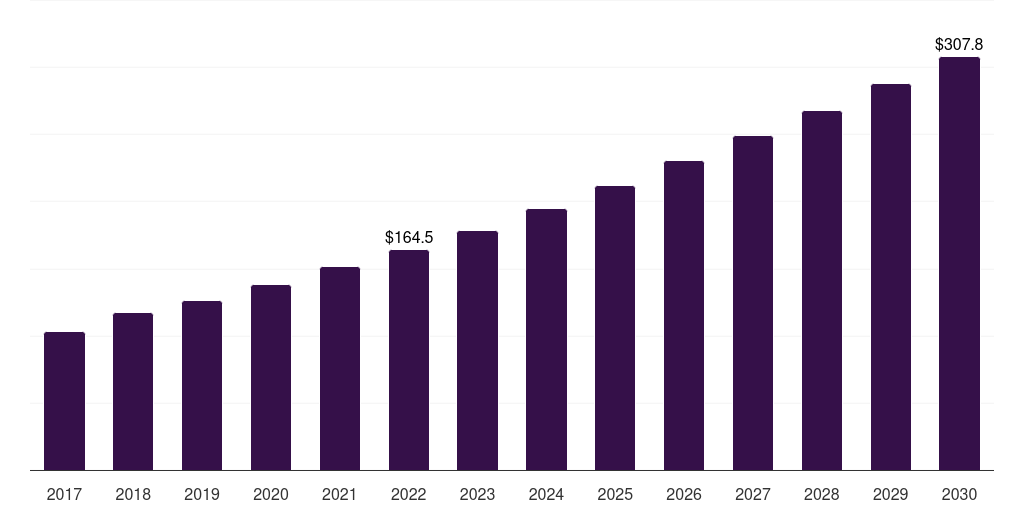Australia Insect Repellent Market Size & Outlook
Australia insect repellent market, 2017-2030 (US$M)

Related Markets
Australia insect repellent market highlights
- The Australia insect repellent market generated a revenue of USD 164.5 million in 2022 and is expected to reach USD 307.8 million by 2030.
- The Australia market is expected to grow at a CAGR of 8.1% from 2023 to 2030.
- In terms of segment, mosquito repellent was the largest revenue generating insect type in 2022.
- Mosquito Repellent is the most lucrative insect type segment registering the fastest growth during the forecast period.
Insect repellent market data book summary
| Market revenue in 2022 | USD 164.5 million |
| Market revenue in 2030 | USD 307.8 million |
| Growth rate | 8.1% (CAGR from 2022 to 2030) |
| Largest segment | Mosquito repellent |
| Fastest growing segment | Mosquito Repellent |
| Historical data | 2017 - 2021 |
| Base year | 2022 |
| Forecast period | 2023 - 2030 |
| Quantitative units | Revenue in USD million |
| Market segmentation | Mosquito Repellent, Bugs Repellent, Fly Repellent |
| Key market players worldwide | Reckitt Benckiser Group PLC, Godrej, Dabur India, Johnson & Johnson, Spectrum Brands Holdings Inc, Henkel AG & Co KGaA, Jyothy Laboratories, Coghlan’s, SC Johnson, Sawyer Products |
Other key industry trends
- In terms of revenue, Australia accounted for 3.4% of the global insect repellent market in 2022.
- Country-wise, China is expected to lead the global market in terms of revenue in 2030.
- In Asia Pacific, China insect repellent market is projected to lead the regional market in terms of revenue in 2030.
- India is the fastest growing regional market in Asia Pacific and is projected to reach USD 610.7 million by 2030.
Mosquito repellent was the largest segment with a revenue share of 49.12% in 2022. Horizon Databook has segmented the Australia insect repellent market based on mosquito repellent, bugs repellent, fly repellent covering the revenue growth of each sub-segment from 2017 to 2030.
Insect repellents are prevalent in Australia due to the country's diverse outdoor lifestyle and a wide range of insect species, some of which can transmit diseases like dengue fever and the Ross River virus.
The warm climate and various natural habitats create an environment conducive to insect activity. Personal insect repellents can be administered to the body through aerosols, lotions, gels, wipes, or via wearable items like bands, patches, or stickers.
Drawing from scientific support, the Western Australia (WA) Department of Health presently suggests the use of lotions, sprays, or gels containing active ingredients such as diethyltoluamide (DEET), picaridin, or p-menthane-3,8-diol (PMD), commonly known as oil of lemon eucalyptus (OLE), for effective protection against insects.
No credit card required*
Horizon in a snapshot
- 30K+ Global Market Reports
- 120K+ Country Reports
- 1.2M+ Market Statistics
- 200K+ Company Profiles
- Industry insights and more
Insect Repellent Market Scope
Insect Repellent Market Companies
| Name | Profile | # Employees | HQ | Website |
|---|
Australia insect repellent market size, by insect type, 2017-2030 (US$M)
Australia Insect Repellent Market Outlook Share, 2022 & 2030 (US$M)
Related regional statistics
Sign up - it's easy, and free!
Sign up and get instant basic access to databook, upgrade
when ready, or enjoy our
free plan indefinitely.
Included in Horizon account
- 30K+ Global Market Reports
- 120K+ Country Reports
- 1.2M+ Market Statistics
- 200K+ Company Profiles
- Industry insights and more


